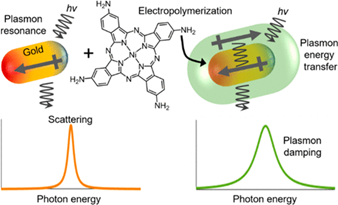
One challenging aspect of extracting energy through the localized surface plasmon resonance of a nanoparticle is achieving high efficiency and deciphering mechanistic principles that govern the reaction pathway. To utilize the plasmon energy for longer, increasing the lifetime of plasmon-generated charge carriers can be attained by hybridizing the plasmonic particle with a diverse range of molecular or polymer organic acceptors. This organic nanohybrids formation offers a way to outcompete internal energy conversion and redistribute charge carriers into the acceptors through two dominant interfacial mechanisms, plasmon-induced charge transfer (CT) and resonance energy transfer (RET). These processes are possible because hybridized soft materials can be manipulated to tune their photophysical and chemical characteristics through changing structural conformation and molecular linkage/functional groups. Single-particle measurements help us to quantify the contributing factors to plasmon dephasing dynamics. The CT and RET processes occurring in plasmonic-organic nanohybrids are directly reflected in the changes in homogeneous linewidth.
Using spectro-electrochemical methods, the Link Research Group, together with the Landes Research Group, seeks to understand the mechanistic principles governing interfacial charge/energy transfer in organic hybrids to efficiently utilize the excited plasmon energy, enabling the rational design of diverse plasmon-driven (electro-)chemistry at the nanoscale. Other light-enhanced electrochemical processes of interest include the dissolution of plasmonic nanoelectrodes to follow hot-hole dynamics. Because this reaction is irreversible, we are developing hyperspectral techniques for faster acquisition of scattering spectra as well as machine learning-based algorithms to predict nanoparticle morphology without the need for correlated electron microscopy.
Selected publications:
- H. Oh, E. K. Searles, S. Chatterjee, Z. Jia, S. A. Lee, S. Link, C. F. Landes, Plasmon Energy Transfer Driven by Electrochemical Tuning of Methylene Blue on Single Gold Nanorods, ACS Nano, 17, 18, 18280–18289 (2023)
- A. Jones, E. K. Searles, M. Mayer, M. Hoffmann, N. Gross, H. Oh, A. Fery, S. Link, C. F. Landes, Active Control of Energy Transfer in Plasmonic Nanorod–Polyaniline Hybrids, J. Phys. Chem. Lett., 14, 36, 8235–8243 (2023)
- A. Al-Zubeidi, Y. Wang, J. Lin, C. Flatebo, C. F. Landes, H. Ren, and and S. Link, d-Band Holes React at the Tips of Gold Nanorods, J. Phys. Chem. Lett. 14, 23, 5297–5304 (2023)
- S. S. E. Collins, E. K. Searles, L. J. Tauzin, M. Lou, L. Bursi, Y. Liu, J. Song, C. Flatebo, R. Baiyasi, Y.-Y. Cai, B. Foerster, T. Lian, P. Nordlander, S. Link, and C. F. Landes, Plasmon Energy Transfer in Hybrid Nanoantennas, ACS Nano, 15 (6), 9522 (2021)
- K. Shiratori, L. D. C. Bishop, B. Ostovar, R. Baiyasi, Y.-Y. Cai, P. J. Rossky, C. F. Landes, and S. Link, Machine-Learned Decision Trees for Predicting Gold Nanorod Sizes from Spectra, J. Phys. Chem. C, 125 (35), 19353 (2021)